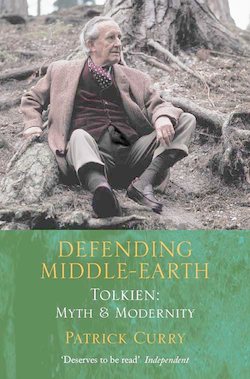Читать книгу Defending Middle-earth: Tolkien: Myth and Modernity - Patrick Curry - Страница 5
· 1 · INTRODUCTION: RADICAL NOSTALGIA
ОглавлениеPeople who Like this sort of thing will find this the sort of thing they like.
It could be a literary fairy-story. A reclusive Oxford don, best-known for his scholarly work on Anglo-Saxon, unexpectedly produces a popular children’s story. Seventeen years later, he follows this up with a very long story, published in three volumes. Set entirely in an imaginary world, it centres on a quest involving a magic ring and some members of a three-and-a-half-foot-tall rustic race called ‘hobbits.’ His book is variously described as romantic epic or juvenile fantasy; but whatever it is, it is certainly not a modern novel, and the critics are divided between bafflement and visceral dislike. The general opinion in the academic and critical neighbourhood is that, rather like one of his characters, its author, ‘who had always been rather cracked, had at last gone quite mad …’ Yet just over ten years later, his books become runaway bestsellers; and after forty years, they count among the most widely read in the global history of publishing.
The author is, of course, John Ronald Reuel Tolkien (1892–1973). Born, in South Africa to English parents, he moved back to England, just outside Birmingham, at the age of three-and-a-half. He developed a childhood passion for languages into a lifelong academic career, interrupted by service in the war of 1914–18. He became Professor first of Anglo-Saxon, then of English Language and Literature, at Oxford, where he remained for the rest of his life. Despite co-editing a respected edition of Sir Gawain and the Green Knight, and writing a paper on Beowulf acclaimed for its brilliance, it was an unremarkable life by many standards … except for those books.
Reliable figures are hard to come by, but as far as I can tell, total worldwide sales of Tolkien’s books are as follows. The Lord of the Rings (1954–55), at about 50 million copies, is probably the biggest-selling single work of fiction this century. The Hobbit (1937) is not far behind, at between 35 and 40 million copies. And one could add the considerable sales, now perhaps over 2 million, of his dark and difficult posthumously published epic The Silmarillion (1977). The grand total is thus well on its way to 100 million. Tolkien’s books have been translated into more than thirty languages, including Japanese, Catalan, Estonian, Greek, Hebrew, Finnish, Indonesian and Vietnamese. (This last, unofficial translation appeared in 1967, whereupon the South Vietnamese II Corps was rather perceptively fêted by tribesmen with shields bearing the Eye of Sauron.)
Furthermore, this is no flash-in-the-pan phenomenon, riding on the heels of the 1960s; Tolkien has outlived the counter-culture in which he first flourished. No longer fashionable, he nonetheless still sells steadily. That was undoubtedly the main reason for the purchase in 1990 of his publisher, Unwin Hyman (originally George Allen and Unwin), by HarperCollins.
Every other index points to the same conclusion. In England, for example, since figures began to be kept in 1991, Tolkien’s books have been taken out of public libraries around 200,000 times a year; he is one of only four ‘classic authors’ whose annual lending totals have exceeded 300,000 (well ahead of Austen, Dickens and Shakespeare). The Hobbit spent fifteen years as the biggest-selling American paperback, and The Lord of the Rings is still the most valuable first edition published in the second half of the twentieth century. Indeed, the latter – laboriously typed out on a bed in suburban war-time Oxford, and expected by its first publisher to lose money – is now universally acknowledged as largely responsible for the subsequent money-spinning genre of ‘fantasy literature.’ Then there are the extra-literary phenomena. In the 1960s and 70s, buttons and graffiti proclaiming ‘Frodo Lives!’ sprouted (in Quebec, it was ‘Middle-earth Libre’). The title of The Silmarillion provided the name of an early heavy-metal band, while on the more establishment side, ‘hobbit’ is now entrenched in the Oxford English Dictionary, and a thousand ‘Lothlóriens’ and ‘Rivendells’ can be found on house-signs in suburban lanes. There is now even an area of submarine features off the southwest coast of Ireland named after Tolkien characters: hence, ‘Gollum’s Channel,’ and so on.
In other words, we are talking about a massively popular and successful publishing phenomenon; all the more so when one of the books in question is half-a-million words long, and neither involves any big money or sex, explicit or otherwise – two ingredients now normally considered essential for bestsellers – let alone cannibalism, serial murder, sadomasochism or lawyers. (And how many such books will still be in print half a century after publication? The fate of Jackie Collins beckons.)
